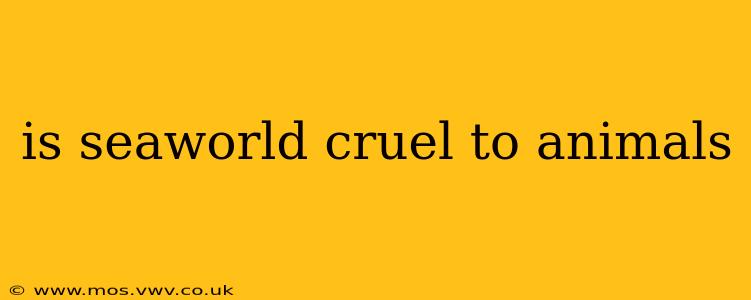Is SeaWorld Cruel to Animals? A Comprehensive Look at the Controversy
SeaWorld's treatment of animals has been a subject of intense debate for years, sparking protests, boycotts, and significant media attention. While SeaWorld maintains that its facilities provide excellent care for its animals, critics argue that the inherent limitations of captivity cause significant stress and suffering. Let's delve into the arguments on both sides and explore the complex ethical considerations.
What are the main criticisms of SeaWorld's treatment of animals?
The primary criticisms against SeaWorld center around the confinement of highly intelligent and social animals in environments far smaller than their natural habitats. These limitations are believed to lead to:
-
Psychological Distress: Orcas, dolphins, and other marine mammals are highly intelligent and social creatures who rely on vast ranges and complex social structures. Confinement can lead to behavioral abnormalities like repetitive swimming patterns (stereotypies), aggression, and depression. Critics argue that these behaviors are clear signs of psychological distress.
-
Physical Health Issues: The confined environments, often lacking the varied diet and stimulation of the open ocean, can contribute to physical health problems. Some studies have linked captivity to a higher incidence of infections, injuries, and shorter lifespans compared to wild populations.
-
Ethical Concerns about Captivity: Many argue that keeping these animals in captivity, regardless of how well-maintained the facilities are, is inherently unethical. They believe that wild animals deserve the freedom to live in their natural environments and exhibit natural behaviors.
Does SeaWorld provide adequate care for its animals?
SeaWorld counters these criticisms by highlighting its veterinary care, training programs, and conservation efforts. They argue that their facilities provide:
-
Veterinary Expertise: SeaWorld employs teams of veterinarians and animal care specialists dedicated to the health and well-being of its animals. They provide regular checkups, vaccinations, and treatment for any illnesses or injuries.
-
Enrichment Programs: SeaWorld implements various enrichment programs aimed at stimulating its animals mentally and physically. These may include interactive toys, specialized diets, and opportunities for social interaction.
-
Conservation Efforts: SeaWorld emphasizes its role in marine mammal rescue and rehabilitation, as well as its contributions to research and conservation programs aimed at protecting wild populations.
How do SeaWorld's breeding programs impact wild populations?
SeaWorld's breeding programs are another point of contention. While SeaWorld argues these programs help maintain genetic diversity and contribute to research, critics express concern that they:
-
Perpetuate Captivity: Breeding programs ensure a constant supply of animals for their facilities, thereby perpetuating the cycle of captivity.
-
May Not Benefit Wild Populations: While research conducted by SeaWorld might be valuable, some argue it doesn't necessarily translate to direct benefits for wild populations.
What are the alternatives to keeping marine mammals in captivity?
Many animal welfare advocates support alternatives to keeping marine mammals in captivity, such as:
-
Sea Sanctuaries: These provide larger, more natural environments for rescued or retired marine mammals, offering a more enriching life than traditional aquariums.
-
Educational Programs Focusing on Conservation: Increased focus on educational programs that raise awareness about the importance of marine conservation and the threats to wild populations can decrease the demand for captive marine animals.
What is SeaWorld doing to address concerns about animal welfare?
In recent years, SeaWorld has made some changes in response to criticism. They have ended their orca breeding program and announced a shift towards a more conservation-focused mission. However, the effectiveness and long-term implications of these changes are still debated.
Conclusion:
The question of whether SeaWorld is cruel to animals remains a complex and highly debated issue. While SeaWorld maintains that it provides excellent care for its animals, many remain unconvinced due to concerns about the inherent limitations of captivity, the psychological and physical well-being of the animals, and the ethical considerations surrounding keeping highly intelligent and social creatures in confined spaces. The ongoing debate highlights the need for continued discussion, improved animal welfare practices, and exploration of more ethical alternatives to marine mammal captivity.
